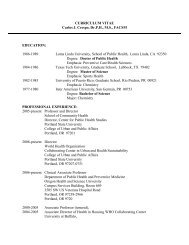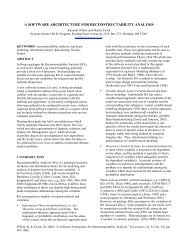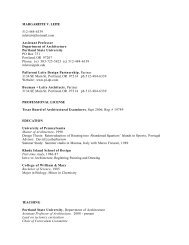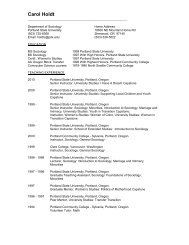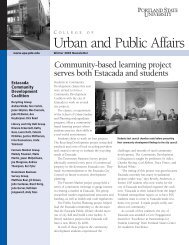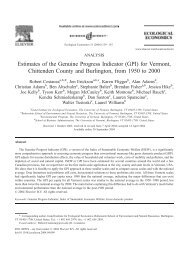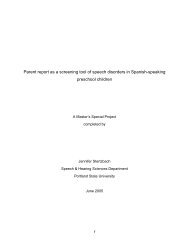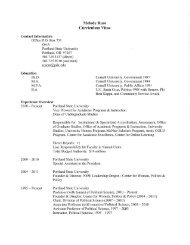Effects of integral stimulation therapy on speech - Portland State ...
Effects of integral stimulation therapy on speech - Portland State ...
Effects of integral stimulation therapy on speech - Portland State ...
You also want an ePaper? Increase the reach of your titles
YUMPU automatically turns print PDFs into web optimized ePapers that Google loves.
Table 4. Summary <str<strong>on</strong>g>of</str<strong>on</strong>g> CP’s c<strong>on</strong>s<strong>on</strong>ant cluster <strong>speech</strong> sound errors<br />
C<strong>on</strong>s<strong>on</strong>ant<br />
Cluster<br />
/bl/ /br/ /dr/ /fl/ /gl/ /gr/ /kl/ /kr/ /kw/ /pl/ /sl/ /sp/ /st/ /sw/ /tr/ /ts/<br />
Error [b] [b] [d] [β] [β,z] [d] * * [d] [b] [s,β] [s,β] [b, ɸ] [s, ɸ] [s,β] [t]<br />
Note: the symbol * indicates omissi<strong>on</strong> <str<strong>on</strong>g>of</str<strong>on</strong>g> ph<strong>on</strong>eme<br />
Speech Sound Inventory<br />
Further analysis <str<strong>on</strong>g>of</str<strong>on</strong>g> CP’s <strong>speech</strong> sound inventory and language abilities was<br />
obtained with a 100 word sp<strong>on</strong>taneous <strong>speech</strong> sample. Analysis <str<strong>on</strong>g>of</str<strong>on</strong>g> the sample utterances<br />
supported findings <str<strong>on</strong>g>of</str<strong>on</strong>g> the GFTA-2 by identifying a wide range <str<strong>on</strong>g>of</str<strong>on</strong>g> <strong>speech</strong> sound errors<br />
within a limited ph<strong>on</strong>emic repertoire. CP’s independent ph<strong>on</strong>etic inventory was greater<br />
than his relati<strong>on</strong>al ph<strong>on</strong>emic inventory. Many errors were made inc<strong>on</strong>sistently and<br />
increased in frequency as the number <str<strong>on</strong>g>of</str<strong>on</strong>g> sounds in a word or phrase length increased. The<br />
percent <str<strong>on</strong>g>of</str<strong>on</strong>g> c<strong>on</strong>s<strong>on</strong>ants CP produced correctly (PCC) was 52%, suggesting a moderate to<br />
severely impaired level <str<strong>on</strong>g>of</str<strong>on</strong>g> <strong>speech</strong> intelligibility (Shriberg, 1994). The most prominent<br />
c<strong>on</strong>s<strong>on</strong>ant error patterns that occurred in CP’s <strong>speech</strong> sample included substituti<strong>on</strong>s<br />
(27%), final c<strong>on</strong>s<strong>on</strong>ant deleti<strong>on</strong>s (37%), cluster reducti<strong>on</strong>s (76%) and occasi<strong>on</strong>al<br />
instances <str<strong>on</strong>g>of</str<strong>on</strong>g> metathesis. Speech sound distorti<strong>on</strong>s and prol<strong>on</strong>gati<strong>on</strong>s were also noted as<br />
part <str<strong>on</strong>g>of</str<strong>on</strong>g> CP’s <strong>speech</strong> analysis. Words that required motor sequencing <str<strong>on</strong>g>of</str<strong>on</strong>g> sounds produced<br />
in differing places in the oral cavity proved most challenging for CP.<br />
Vowel errors in CP’s <strong>speech</strong> occurred with a frequency <str<strong>on</strong>g>of</str<strong>on</strong>g> 59%. Vowel sounds<br />
[ǫ, Ȝ, and ƽ] were err<strong>on</strong>eously produced in 82% <str<strong>on</strong>g>of</str<strong>on</strong>g> vowel substituti<strong>on</strong>s (Table 5). CP did<br />
not produce (nor was he stimulable for) /i/, /u/, /Ț/ or any rhotic vowels. CP substituted<br />
34



